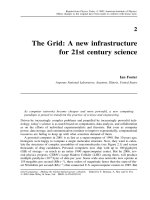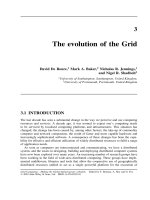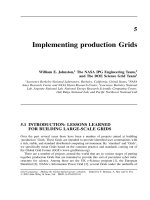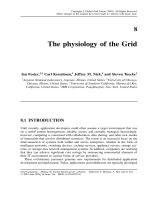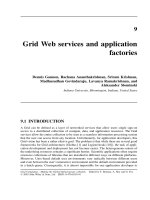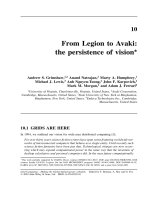Grid Computing P4
Bạn đang xem bản rút gọn của tài liệu. Xem và tải ngay bản đầy đủ của tài liệu tại đây (114.41 KB, 15 trang )
Reprint from Concurrency: Practice and Experience, 10(7), 1998, 567–581
1998 John Wiley & Sons, Ltd.
Minor changes to the original have been made to conform with house style.
4
Software infrastructure for the
I-WAY high-performance
distributed computing experiment
Ian Foster, Jonathan Geisler, Bill Nickless, Warren Smith,
and Steven Tuecke
Argonne National Laboratory, Argonne, Illinois, United States
4.1 INTRODUCTION
Recent developments in high-performance networks, computers, information servers, and
display technologies make it feasible to design network-enabled tools that incorporate
remote compute and information resources into local computational environments and
collaborative environments that link people, computers, and databases into collaborative
sessions. The development of such tools and environments raises numerous technical
problems, including the naming and location of remote computational, communication,
and data resources; the integration of these resources into computations; the location,
characterization, and selection of available network connections; the provision of security
and reliability; and uniform, efficient access to data.
Grid Computing – Making the Global Infrastructure a Reality. Edited by F. Berman, A. Hey and G. Fox
2003 John Wiley & Sons, Ltd ISBN: 0-470-85319-0
102
IAN FOSTER ET AL.
Previous research and development efforts have produced a variety of candidate ‘point
solutions’ [1]. For example, DCE, CORBA, Condor [2], Nimrod [3], and Prospero [4]
address problems of locating and/or accessing distributed resources; file systems such as
AFS [5], DFS, and Truffles [6] address problems of sharing distributed data; tools such as
Nexus [7], MPI [8], PVM [9], and Isis [10] address problems of coupling distributed com-
putational resources; and low-level network technologies such as Asynchronous Transfer
Mode (ATM) promise gigabit/sec communication. However, little work has been done to
integrate these solutions in a way that satisfies the scalability, performance, functionality,
reliability, and security requirements of realistic high-performance distributed applications
in large-scale internetworks.
It is in this context that the I-WAY project [11] was conceived in early 1995, with
the goal of providing a large-scale testbed in which innovative high-performance and
geographically distributed applications could be deployed. This application focus, argued
the organizers, was essential if the research community was to discover the critical tech-
nical problems that must be addressed to ensure progress, and to gain insights into the
suitability of different candidate solutions. In brief, the I-WAY was an ATM network con-
necting supercomputers, mass storage systems, and advanced visualization devices at 17
different sites within North America. It was deployed at the Supercomputing conference
(SC’95) in San Diego in December 1995 and used by over 60 application groups for
experiments in high-performance computing, collaborative design, and the coupling of
remote supercomputers and databases into local environments.
A central part of the I-WAY experiment was the development of a management and
application programming environment, called I-Soft. The I-Soft system was designed to
run on dedicated I-WAY point of presence (I-POP) machines deployed at each partici-
pating site, and provided uniform authentication, resource reservation, process creation,
and communication functions across I-WAY resources. In this article, we describe the
techniques employed in I-Soft development, and we summarize the lessons learned dur-
ing the deployment and evaluation process. The principal contributions are the design,
prototyping, preliminary integration, and application-based evaluation of the following
novel concepts and techniques:
1. Pointofpresencemachines as a structuring and management technique for wide-area
distributed computing.
2. A computational resource broker that uses scheduler proxies to provide a uniform
scheduling environment that integrates diverse local schedulers.
3. The use of authorization proxies to construct a uniform authentication environment
and define trust relationships across multiple administrative domains.
4. Network-aware parallel programming tools that use configuration information regard-
ing topology, network interfaces, startup mechanisms, and node naming to provide a
uniform view of heterogeneous systems and to optimize communication performance.
The rest of this article is as follows. In Section 4.2, we review the applications that moti-
vated the development of the I-WAY and describe the I-WAY network. In Section 4.3, we
introduce the I-WAY software architecture, and in Sections 4.4–4.8 we describe various
components of this architecture and discuss lessons learned when these components were
SOFTWARE INFRASTRUCTURE
103
used in the I-WAY experiment. In Section 4.9, we discuss some related work. Finally, in
Section 4.10, we present our conclusions and outline directions for future research.
4.2 THE I-WAY EXPERIMENT
For clarity, in this article we refer consistently to the I-WAY experiment in the past
tense. However, we emphasize that many I-WAY components have remained in place
after SC’95 and that follow-on systems are being designed and constructed.
4.2.1 Applications
A unique aspect of the I-WAY experiment was its application focus. Previous gigabit
testbed experiments focused on network technologies and low-level protocol issues, using
either synthetic network loads or specialized applications for experiments (e.g., see [12]).
The I-WAY, in contrast, was driven primarily by the requirements of a large application
suite. As a result of a competitive proposal process in early 1995, around 70 application
groups were selected to run on the I-WAY (over 60 were demonstrated at SC’95). These
applications fell into three general classes [11]:
1. Many applications coupled immersive virtual environments with remote supercomput-
ers, data systems, and/or scientific instruments. The goal of these projects was typically
to combine state-of-the-art interactive environments and backend supercomputing to
couple users more tightly with computers, while at the same time achieving distance
independence between resources, developers, and users.
2. Other applications coupled multiple, geographically distributed supercomputers in order
to tackle problems that were too large for a single supercomputer or that benefited from
executing different problem components on different computer architectures.
3. A third set of applications coupled multiple virtual environments so that users at
different locations could interact with each other and with supercomputer simulations.
Applications in the first and second classes are prototypes for future ‘network-enabled
tools’ that enhance local computational environments with remote compute and infor-
mation resources; applications in the third class are prototypes of future collaborative
environments.
4.2.2 The I-WAY network
The I-WAY network connected multiple high-end display devices (including immer-
sive CAVE
TM
and ImmersaDesk
TM
virtual reality devices [13]); mass storage systems;
specialized instruments (such as microscopes); and supercomputers of different architec-
tures, including distributed memory multicomputers (IBM SP, Intel Paragon, Cray T3D,
etc.), shared-memory multiprocessors (SGI Challenge, Convex Exemplar), and vector
multiprocessors (Cray C90, Y-MP). These devices were located at 17 different sites across
North America.
104
IAN FOSTER ET AL.
This heterogeneous collection of resources was connected by a network that was itself
heterogeneous. Various applications used components of multiple networks (e.g., vBNS,
AAI, ESnet, ATDnet, CalREN, NREN, MREN, MAGIC, and CASA) as well as additional
connections provided by carriers; these networks used different switching technologies
and were interconnected in a variety of ways. Most networks used ATM to provide
OC-3 (155 Mb s
−1
) or faster connections; one exception was CASA, which used HIPPI
technology. For simplicity, the I-WAY standardized on the use of TCP/IP for application
networking; in future experiments, alternative protocols will undoubtedly be explored. The
need to configure both IP routing tables and ATM virtual circuits in this heterogeneous
environment was a significant source of implementation complexity.
4.3 I-WAY INFRASTRUCTURE
We now describe the software (and hardware) infrastructure developed for I-WAY man-
agement and application programming.
4.3.1 Requirements
We believe that the routine realization of high-performance, geographically distributed
applications requires a number of capabilities not supported by existing systems. We
list first user-oriented requirements; while none has been fully addressed in the I-WAY
software environment, all have shaped the solutions adopted.
1. Resource naming and location: The ability to name computational and information
resources in a uniform, location-independent fashion and to locate resources in large
internets based on user or application-specified criteria.
2. Uniform programming environment: The ability to construct parallel computations that
refer to and access diverse remote resources in a manner that hides, to a large extent,
issues of location, resource type, network connectivity, and latency.
3. Autoconfiguration and resource characterization: The ability to make sensible configu-
ration choices automatically and, when necessary, to obtain information about resource
characteristics that can be used to optimize configurations.
4. Distributed data services: The ability to access conceptually ‘local’ file systems in a
uniform fashion, regardless of the physical location of a computation.
5. Trust management: Authentication, authorization, and accounting services that oper-
ate even when users do not have strong prior relationships with the sites controlling
required resources.
6. Confidentiality and integrity: The ability for a computation to access, communicate,
and process private data securely and reliably on remote sites.
Solutions to these problems must be scalable to large numbers of users and resources.
The fact that resources and users exist at different sites and in different administra-
tive domains introduces another set of site-oriented requirements. Different sites not only
SOFTWARE INFRASTRUCTURE
105
provide different access mechanisms for their resources, but also have different policies
governing their use. Because individual sites have ultimate responsibility for the secure
and proper use of their resources, we cannot expect them to relinquish control to an exter-
nal authority. Hence, the problem of developing management systems for I-WAY–like
systems is above all one of defining protocols and interfaces that support a negotiation
process between users (or brokers acting on their behalf) and the sites that control the
resources that users want to access.
The I-WAY testbed provided a unique opportunity to deploy and study solutions to
these problems in a controlled environment. Because the number of users (few hundred)
and sites (around 20) were moderate, issues of scalability could, to a large extent, be
ignored. However, the high profile of the project, its application focus, and the wide
range of application requirements meant that issues of security, usability, and generality
were of critical concern. Important secondary requirements were to minimize development
and maintenance effort, for both the I-WAY development team and the participating sites
and users.
4.3.2 Design overview
In principle, it would appear that the requirements just elucidated could be satisfied with
purely software-based solutions. Indeed, other groups exploring the concept of a ‘meta-
computer’ have proposed software-only solutions [14, 15]. A novel aspect of our approach
was the deployment of a dedicated I-WAY point of presence, or I-POP, machine at each
participating site. As we explain in detail in the next section, these machines provided a
uniform environment for deployment of management software and also simplified valida-
tion of security solutions by serving as a ‘neutral’ zone under the joint control of I-WAY
developers and local authorities.
Deployed on these I-POP machines was a software environment, I-Soft, providing a
variety of services, including scheduling, security (authentication and auditing), parallel
programming support (process creation and communication), and a distributed file system.
These services allowed a user to log on to any I-POP and then schedule resources on
heterogeneous collections of resources, initiate computations, and communicate between
computers and with graphics devices – all without being aware of where these resources
were located or how they were connected.
In the next four sections, we provide a detailed discussion of various aspects of the
I-POP and I-Soft design, treating in turn the I-POPs, scheduler, security, parallel pro-
gramming tools, and file systems. The discussion includes both descriptive material and a
critical presentation of the lessons learned as a result of I-WAY deployment and demon-
stration at SC’95.
4.4 POINT OF PRESENCE MACHINES
We have explained why management systems for I-WAY–like systems need to interface
to local management systems, rather than manage resources directly. One critical issue
that arises in this context is the physical location of the software used to implement these
106
IAN FOSTER ET AL.
interfaces. For a variety of reasons, it is desirable that this software execute behind site
firewalls. Yet this location raises two difficult problems: sites may, justifiably, be reluctant
to allow outside software to run on their systems; and system developers will be required
to develop interfaces for many different architectures.
The use of I-POP machines resolve these two problems by providing a uniform, jointly
administered physical location for interface code. The name is chosen by analogy with
a comparable device in telephony. Typically, the telephone company is responsible for,
and manages, the telephone network, while the customer owns the phones and in-house
wiring. The interface between the two domains lies in a switchbox, which serves as the
telephone company’s ‘point of presence’ at the user site.
4.4.1 I-POP design
Figure 4.1 shows the architecture of an I-POP machine. It is a dedicated workstation,
accessible via the Internet and operating inside a site’s firewalls. It runs a standard set of
software supplied by the I-Soft developers. An ATM interface allows it to monitor and,
in principle, manage the site’s ATM switch; it also allows the I-POP to use the ATM
network for management traffic. Site-specific implementations of a simple management
interface allow I-WAY management systems to communicate with other machines at the
site to allocate resources to users, start processes on resources, and so forth. The Andrew
distributed file system (AFS) [5] is used as a repository for system software and status
information.
Development, maintenance, and auditing costs are significantly reduced if all I-POP
computers are of the same type. In the I-WAY experiment, we standardized on Sun
SPARCStations. A standard software configuration included SunOS 4.1.4 with latest
AT M
Internet
ATM Switch
I-POP
AFS
Kerberos Scheduler
Local
Resource 1
Local
Resource N
possible firewall
Figure 4.1 An I-WAY point of presence (I-POP) machine.

